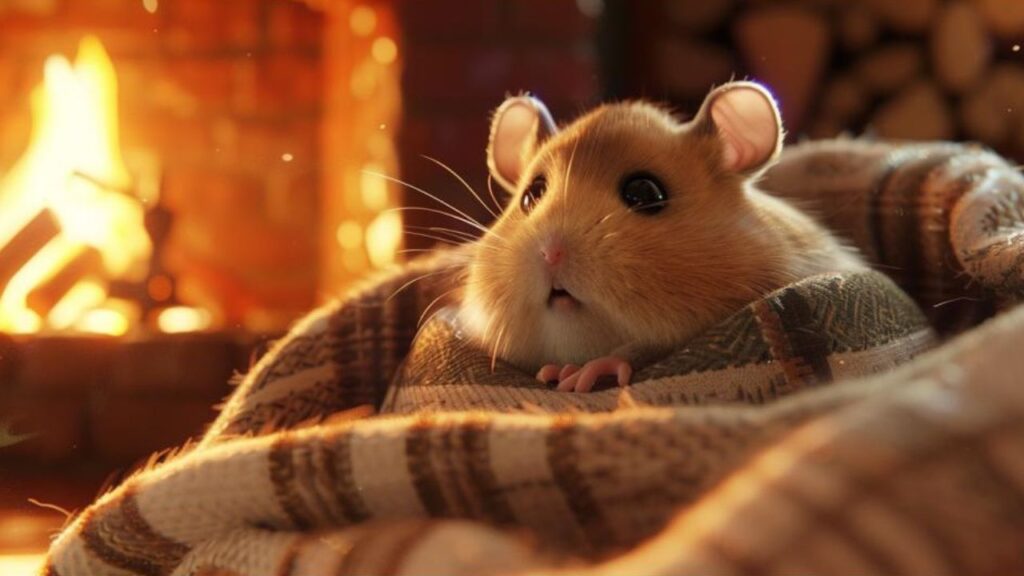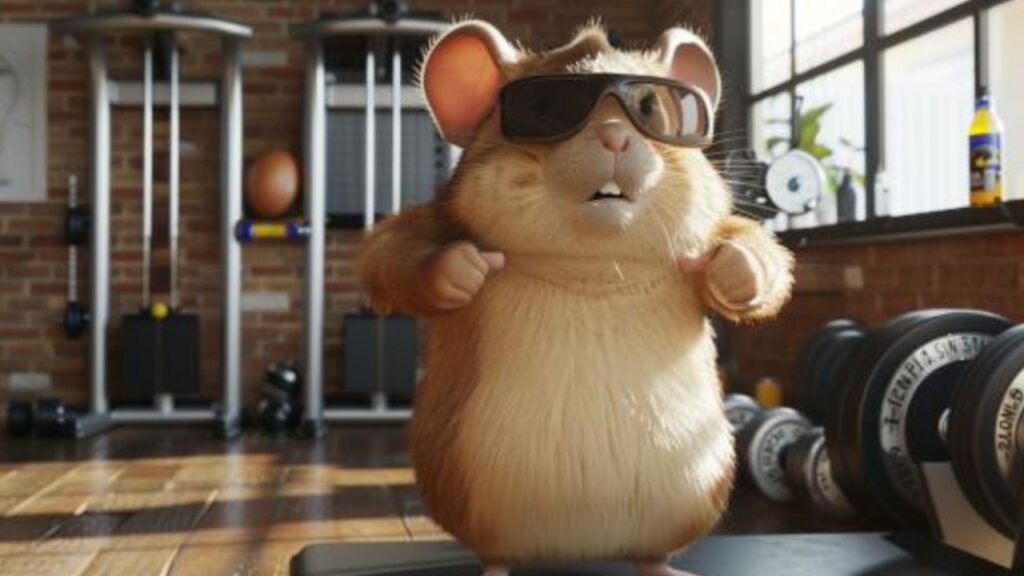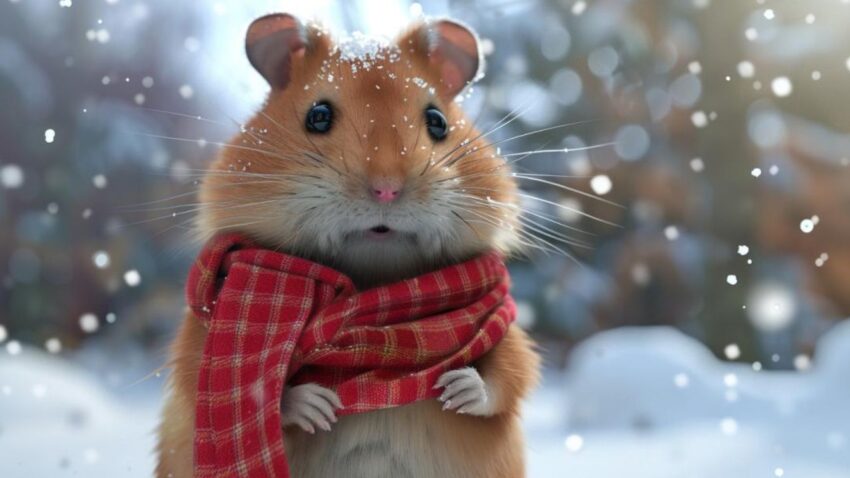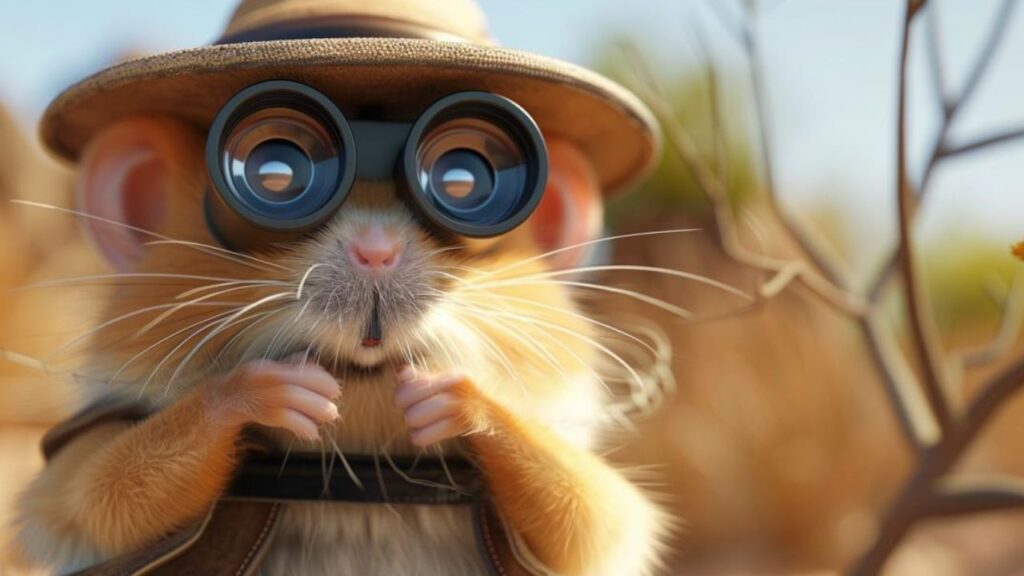As the leaves turn and the air chills, our thoughts naturally drift towards keeping our homes and ourselves warm. But what about our small, furry friends? Hamsters, with their diminutive size and limited ability to regulate body temperature, face unique challenges as the seasons change. In this section, we’ll delve into the essentials of hamster winter care, ensuring your little companion remains happy and healthy during the colder months.
Understanding Your Hamster’s Needs in Winter
Hamsters are creatures of comfort and warmth. In their natural habitats, they adapt to seasonal changes by burrowing deep into the ground to escape the cold. In the confines of our homes, however, they rely entirely on us to mimic these conditions and meet their winter needs. This includes maintaining an optimal temperature range in their habitat, providing adequate bedding for burrowing, and ensuring their diet supports their increased energy needs during colder periods. Understanding these needs is the first step in creating a cozy winter haven for your hamster.
The Importance of a Warm Environment
A warm environment is crucial for your hamster’s health and well-being during winter. These little creatures are highly susceptible to respiratory infections and other health issues if they become too cold. The ideal temperature for a hamster’s habitat should be kept between 65°F and 75°F (18°C to 24°C). Temperatures below this range can lead to cold stress, a condition where the hamster’s body is unable to maintain its normal metabolic rate due to the cold, leading to a host of potential health problems.
Recognizing Signs of Cold Stress in Hamsters
Recognizing the signs of cold stress in your hamster is vital for their well-being. Symptoms can include lethargy, huddling in a ball for extended periods (beyond their normal sleeping habits), refusal to eat, and, in severe cases, hypothermia. If you notice these signs, it’s essential to gently warm your hamster and consult with a veterinarian for further advice. Remember, prevention is key during the winter months, and keeping a close eye on your hamster’s behavior and environment will go a long way in ensuring they stay warm and cozy.
Optimizing the Habitat for Winter

As the winter season approaches, ensuring your hamster’s habitat is a warm and inviting sanctuary becomes a top priority. A well-optimized habitat not only keeps your furry friend comfortable but also shields them from the adverse effects of cold stress. Let’s explore how to enhance bedding, regulate temperature, and safely heat your hamster’s environment, making it a cozy retreat from the winter chill.
Bedding and Nesting Materials
The foundation of a warm habitat starts with the right bedding and nesting materials. These elements serve as insulation, keeping your hamster snug and warm. For bedding, opt for a thick layer of paper-based or aspen bedding, avoiding pine or cedar, which can be harmful. Aim for a depth that allows your hamster to burrow and create intricate tunnel systems, mimicking their natural behavior and providing an additional layer of warmth.
For nesting materials, provide ample amounts of soft, unscented tissue paper or commercial nesting material. Your hamster will instinctively shred and arrange these materials to build a cozy nest. Regularly replenishing these materials ensures your hamster always has resources to maintain and adjust their nest to their comfort level.
Temperature Regulation Techniques
Maintaining an optimal temperature within your hamster’s habitat is crucial for their well-being during winter. Here are several techniques to regulate temperature effectively:
- Location: Keep the cage away from windows, doors, and areas prone to drafts. A stable room temperature is easier to maintain in interior spaces.
- Room Temperature: Use a room thermostat to monitor the ambient temperature, ensuring it remains within the 65°F to 75°F (18°C to 24°C) range.
- Insulation: Consider insulating the habitat with a cage cover or blanket during the coldest parts of the day or night. Ensure there’s adequate ventilation to prevent the buildup of humidity and maintain air quality.
Safe Heating Solutions
When natural methods fall short, especially during extreme cold, safe heating solutions can provide additional warmth. However, safety is paramount to prevent accidents or overheating:
- Under-cage Heating: Use a reptile heating pad under one side of the cage to create a temperature gradient, allowing your hamster to choose their preferred warmth level. Always follow the manufacturer’s instructions to avoid overheating the habitat.
- Ceramic Heat Emitter: A ceramic heat emitter (CHE) in a lamp fixture can be installed above the cage to provide warmth without emitting light, disrupting your hamster’s nocturnal schedule. Use a thermostat to control the emitter, ensuring the habitat remains within a safe temperature range.
- Room Heaters: If you’re using a room heater, maintain a consistent room temperature indirectly warming the hamster’s habitat. Avoid direct heat sources or hot air blowing directly onto the cage to prevent rapid temperature fluctuations or dehydration.
By focusing on bedding and nesting materials, employing temperature regulation techniques, and utilizing safe heating solutions, you can create a winter-proof habitat that keeps your hamster warm, cozy, and healthy throughout the cold months. Remember, the key to successful winter care lies in monitoring and adjusting the environment as needed to maintain the perfect balance of warmth and comfort.
Nutritional Needs During the Colder Months

Winter not only challenges our hamsters with colder temperatures but also demands adjustments in their dietary regimen to keep them energetic and healthy. As the mercury dips, your hamster’s metabolic rate can increase as they strive to maintain body warmth, subsequently elevating their energy requirements. Let’s nibble away at how to adjust your hamster’s diet, incorporate supplements and treats for extra energy, and ensure their hydration needs are met without the risk of water freezing.
Adjusting Your Hamster’s Diet for Winter
During winter, your hamster’s diet may need a slight boost in calories to help them sustain their body temperature. This doesn’t mean a complete overhaul of their existing diet but a thoughtful enhancement:
- Increase Protein and Fat: Incorporate a slightly higher proportion of protein and fat into their diet. This can be achieved by adding small pieces of cooked chicken, hard-boiled egg, or mealworms to their daily food mix. A small increase in seeds high in fat, like sunflower or pumpkin seeds, can also be beneficial. However, these should be given in moderation to avoid obesity.
- Fiber-Rich Foods: Ensure their diet remains rich in fiber to support digestive health. Timothy hay or alfalfa can provide both warmth for nesting and additional fiber.
- Fresh Fruits and Vegetables: Continue offering fresh fruits and vegetables to provide essential vitamins and minerals. However, reduce the quantity slightly to avoid excess water intake, which can lead to chilling.
Supplements and Treats for Extra Energy
Winter is an ideal time to introduce certain supplements and treats to provide your hamster with bursts of extra energy and nutrients:
- Vitamin Supplements: Consult with your veterinarian about adding vitamin supplements to your hamster’s diet, especially Vitamin C for Syrian hamsters, which can be prone to deficiency.
- Energy-Rich Treats: Offer small, energy-rich treats like nuts or a tiny bit of cheese. These treats should be considered extras and not replace their balanced diet. Always introduce new treats gradually and in small quantities to avoid digestive upset.
Hydration: Keeping Water from Freezing
Hydration remains a critical aspect of your hamster’s health during winter, requiring creative solutions to prevent water from freezing:
- Check Water Bottle Regularly: In colder environments, water bottles can freeze, leaving your hamster without access to water. Regularly check the water bottle to ensure water is flowing freely.
- Insulate the Water Bottle: Consider insulating the water bottle with a commercial cover or a DIY solution like wrapping it in a small towel. Ensure the drinking spout is not obstructed.
- Room Temperature: Keeping the room at a stable temperature not only benefits your hamster’s overall warmth but also prevents the water bottle from freezing.
By thoughtfully adjusting your hamster’s diet for winter, introducing supplements and treats for extra energy, and ensuring their water supply remains unfrozen, you can support their well-being through the coldest months. These dietary adjustments and hydration strategies play a vital role in keeping your furry friend active, healthy, and cozy all winter long.
Exercise and Entertainment in Winter

The chilly embrace of winter often means more time spent indoors, not just for us but for our furry hamster friends too. While the colder months can limit some outdoor and exploratory activities, they also offer a unique opportunity to enrich our hamsters’ lives in new and creative ways. Keeping your hamster active and entertained through the winter is crucial for their physical health and mental well-being. Let’s dive into how we can keep our hamsters bustling with activity indoors, engage them with DIY toys and challenges, and understand the importance of social interaction and bonding during these long winter months.
Keeping Your Hamster Active Indoors
The drop in temperature shouldn’t mean a drop in activity for your hamster. Here’s how to ensure they stay active:
- Upgrade Their Exercise Wheel: Ensure the wheel in your hamster’s cage is of the appropriate size and type for their breed. A solid surface wheel with a diameter that allows them to run without arching their back is ideal. Consider upgrading to a larger or more engaging wheel for the winter months.
- Create an Indoor Playpen: Set up a safe, supervised play area outside their cage. Use cardboard, playpen fencing, or even a dry bathtub to create a space where they can explore. Add tunnels, cardboard boxes, and safe toys for them to investigate.
- Routine Playtime: Establish a routine that includes daily playtime outside the cage. This consistency helps your hamster burn energy and satisfy their curiosity, keeping their mind and body active.
DIY Toys and Challenges for Mental Stimulation
Stimulating your hamster’s mind is just as important as physical exercise. Here are some DIY ideas:
- Homemade Tunnels and Mazes: Use cardboard rolls, boxes, and safe, non-toxic materials to construct tunnels and mazes. These can stimulate your hamster’s natural burrowing and exploring instincts.
- Foraging Toys: Hide treats in small, homemade puzzles or foraging toys to encourage natural foraging behavior. This not only entertains them but also makes them work a little for their treats, mirroring their natural activities.
- Interactive Toys: Consider crafting toys that move or change, such as a cardboard wheel they can push around or a treat ball that releases snacks as it rolls. These toys can provide hours of engagement.
The Role of Social Interaction and Bonding
While hamsters are often seen as solitary animals, they do benefit from interaction with their human companions, especially during the less stimulating winter months:
- Handling and Bonding: Spend time each day handling your hamster, allowing them to become comfortable with your presence and touch. This can help reduce stress and promote a sense of security.
- Training and Tricks: Believe it or not, hamsters can learn simple tricks and commands, especially with the help of treats. Teaching your hamster to come when called or navigate through a simple obstacle course can be a fun way to interact.
- Watching and Learning: Sometimes, just watching and talking to your hamster can be a form of social interaction. They get used to your voice and presence, which can be comforting to them.
Winter doesn’t have to be a dreary time for your hamster. With a little creativity and effort, you can ensure they remain active, engaged, and happy throughout the season. Remember, a hamster that’s busy exploring, playing, and interacting is a hamster that’s mentally and physically healthy.
Health and Wellness Checks in Winter

The brisk winter months bring not only a change in the weather but also a shift in the health and wellness needs of our hamster companions. As their caregivers, it’s our duty to ensure that they not only survive but thrive during this time. Vigilant observation for any health issues, regular veterinary check-ups, and proactive preventive measures are paramount. Let’s burrow deeper into the aspects of winter wellness checks, ensuring your hamster remains hale and hearty throughout the colder season.
Monitoring for Signs of Winter-Related Health Issues
The drop in temperature and potential changes in activity levels can make hamsters susceptible to a range of winter-related health issues. Being proactive in monitoring your hamster can help catch and address problems early. Key signs to watch for include:
- Respiratory Problems: Sniffling, sneezing, or labored breathing can indicate colds or respiratory infections, which are more common in cold drafts or sudden temperature changes.
- Changes in Activity Levels: While some decrease in activity might be normal due to the colder, darker days, significant lethargy or, conversely, restlessness can indicate discomfort or health issues.
- Appetite and Weight Changes: A decrease in appetite or noticeable weight loss can signal health problems. Conversely, significant weight gain from overfeeding and reduced activity can lead to obesity-related issues.
- Skin and Fur Conditions: Dry air and reduced grooming can lead to skin and fur problems. Watch for bald patches, flaking, or unusual scratching.
The Importance of Regular Vet Visits
Regular veterinary visits are crucial, especially in the winter months when hamsters are more prone to health issues. A vet specialized in small animals can provide:
- Seasonal Health Checks: A professional assessment to catch any emerging health concerns early.
- Dietary Recommendations: Advice on adjusting your hamster’s diet to meet their winter needs.
- General Wellness: Tips on keeping your hamster active and mentally stimulated during the less active winter months.
Make sure your hamster has a check-up before winter sets in, and don’t hesitate to schedule another if you notice any health concerns.
Preventive Measures and Emergency Preparedness
Taking proactive steps can significantly reduce the risk of winter-related health issues:
- Maintain a Stable Environment: Keep the habitat away from drafts, dampness, and extreme temperature changes.
- Balanced Diet and Hydration: Ensure access to fresh, unfrozen water and a diet that supports their health needs during colder months.
- Emergency Kit: Have an emergency kit ready, including extra bedding, food, a warm bottle or heating pad, and contact information for your vet. This is crucial in case of power outages or if you can’t reach a store or clinic immediately.
Regularly update yourself on first-aid measures for hamsters and have a plan in place should your pet require immediate care. Knowing the signs of common hamster ailments and how to respond can be a lifesaver.
Winter can be a challenging time for hamsters, but with attentive care, regular health checks, and preventative measures, you can ensure your furry friend stays healthy and happy. Remember, proactive hamster care in the winter not only prevents health issues but also strengthens the bond between you and your pet.
Whisker Tips for Hamster Winter Care

Ah, winter—the season of snowflakes, hot cocoa, and cozy blankets. But as we wrap ourselves in layers of warmth, let’s not forget our tiny, whiskered companions who rely on us to navigate through the colder months. Over my years of caring for these delightful creatures, I’ve gathered a trove of tips and insights to ensure your hamster enjoys a snug and safe winter. Let’s dive into some Whisker Tips that cover quick and easy warmth boosters, essential do’s and don’ts of winter care, and share a few personal observations and case studies from my own experiences.
Quick and Easy Warmth Boosters
Keeping your hamster warm doesn’t have to be a Herculean task. Here are a few simple yet effective strategies:
- Extra Bedding: Pile on the bedding! A thick layer of bedding allows your hamster to burrow and create a warm nest. Paper-based or aspen bedding is ideal.
- Nest Box: A small, enclosed box filled with soft nesting material can serve as a perfect hideout and warm space for your hamster.
- Warm Bottles: In extreme cold, a warm water bottle wrapped in a towel and placed outside the cage can radiate gentle warmth. Be sure to monitor closely to avoid overheating.
The Do’s and Don’ts of Winter Care
To navigate the winter season successfully, here are some key do’s and don’ts:
Do:
- Do maintain a consistent temperature in the room where your hamster’s cage is located.
- Do check the water bottle daily to ensure it’s not frozen and that your hamster has access to fresh water.
- Do monitor your hamster’s health more vigilantly, watching for signs of cold stress or other health issues.
Don’t:
- Don’t place the cage near drafty windows or doors, where cold drafts can cause temperature fluctuations.
- Don’t use electric heaters directly next to the cage without a thermostat, as they can cause overheating or fire hazards.
- Don’t ignore changes in behavior, as they can be the first sign of a health issue needing attention.
Personal Observations and Case Studies
Over the years, I’ve witnessed firsthand how a little extra care during the winter can make a big difference in a hamster’s life. For instance, a case involving a little Syrian named Marbles highlighted the importance of temperature monitoring. Marbles began to show signs of lethargy and reduced appetite as the temperature in his room dropped below the ideal range. By adjusting the room temperature and adding extra bedding for burrowing, Marbles quickly returned to his usual, energetic self.
Another observation is the impact of dietary adjustments. Increasing the proportion of protein and fat in the diet of a hamster named Jingles helped him maintain energy levels and a healthy weight throughout winter, showcasing the significance of nutritional considerations during the colder months.
Winter care for hamsters involves a blend of warmth, nutrition, and vigilant health monitoring. By adopting these Whisker Tips, you can ensure your hamster not only survives but thrives during the winter season. Remember, the key to a happy hamster is understanding and catering to their needs, especially when the temperature drops.
Conclusion: Ensuring a Joyful Winter for Your Hamster

As we wrap up our cozy journey through the essentials of winter care for our hamster friends, it’s important to reflect on the key insights and strategies we’ve shared. Navigating the winter months with your furry companion can be a heartwarming experience, filled with moments of bonding and care that not only ensure their well-being but also deepen the connection you share. Let’s recap the vital points we’ve covered, offer some final encouragement for proactive hamster care, and leave you with a whisker of wisdom to carry through the winter season.
Recap of Key Points
We started by understanding the unique challenges winter poses to hamsters, emphasizing the importance of a warm and comfortable habitat, a nutritious diet tailored for colder months, and the necessity of keeping your hamster active and engaged. We also discussed the critical aspect of health and wellness checks to preemptively address any winter-related health issues. Our Whisker Tips provided practical advice on providing extra warmth, the essential do’s and don’ts of winter care, and shared valuable insights from personal observations and case studies.
Encouragement for Proactive Hamster Care
Caring for a hamster during winter requires a proactive approach, attentiveness, and a dash of creativity. The effort you put into adapting their environment, diet, and daily routine not only safeguards their physical health but also nurtures their emotional well-being. Remember, your hamster relies on you entirely for comfort and security during the cold season. Embrace this responsibility with love and dedication, and witness the joy and vibrancy your care brings to their little lives. Let each day be an opportunity to enrich your hamster’s world, creating a warm bubble of happiness that defies the cold outside.
Signature Phrase
As we conclude, I hope this guide serves as a beacon, guiding you through the winter months with confidence and ease. Remember, the care we bestow upon our hamsters reflects the warmth and compassion within our hearts. And as the snow falls and the wind howls, let’s hold this thought close: “Remember, a happy hamster is a wheel-y happy you!”
By following these guidelines and embracing the spirit of proactive care, you’re not just ensuring your hamster survives the winter—you’re ensuring they thrive, bringing light and joy into the darkest months. So, bundle up, get cozy, and enjoy the winter wonderland with your furry friend by your side.




